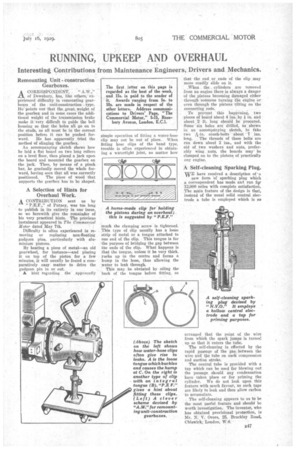RUNNING, UPKEEP AND OVERHAUL
Page 73

If you've noticed an error in this article please click here to report it so we can fix it.
Interesting Contributions from Maintenance Engineers, Drivers and Mechanics.
Remounting Unit construction Gearboxes.
A CORRESPONDENT, " A.W.," it of Dewsbury, has, like others,experienced difficulty in temounting gearboxes of the . unit-construction type. lie points out' that the, great weight of the gearbox and in some cases the additional weight of the transmission brake make it very difficult to guide the bell housing so that the holes all go on to the studs, as all must be in the correct position before it can be pushed for
ward. He has apparently tried the method of slinging the gearbox.
Au accompanying sketch shows how he laid a flat board on two long rollers on a level floor, then placed a jack upon the board and mounthd the gearbox on the jack. Then, by means of a pinch bar, he gradually moved the whole forward, having seen that all was correctly positioned, The piece of wood that supports• the gearbox has to be shaped.
A Selection of Hints for Overhaul Work.
A CONTRIBUTION sent us by
" P.E.F.," of Putney, was too long to publish in its entirety in one issue, so we herewith give the remainder of his very practical hints. The previous instalment appeared in The Commercial Motor dated May 7th.
Difficulty is often experienced in removing or replacing non-floating gudgeon pins, particularly with aluminium pistons.
By heating a piece of metal—an old gearwheel, for instance—and placing it on top of the piston for a few minutes, it will usually be found a comparatively easy matter to drive the gudgeon pin in or out.
A hint regarding the apparently
simple operation of fitting a water-hose clip may not be out of place. When fitting hose clips of the band type, trouble is often experienced in obtaining a watertight joint, no matter how
much the clamping screw is tightened. This type of clip usually has a loose strip of metal or a tongue attached to one end of the clip. This tongue is for the purpose of bridging the gap between the ends of the clip. What happens is that the tongue, unless it be very thick. rucks up in the centre and forms a hump in the hose, thus allowing the water to leak through.
This may be obviated by oiling the back of the tongue before fitting, so that the end or ends of the clip may more readily slide on it.
.When the cylinders are removed from an engine there is always a danger of the pistons becoming damaged either through someone turning the engine or even through the pistons tilting on the connecting rods.
To prevent this happening, two pieces of board about 4 ins..by I in. and about 2 ft. long should be procured. Some six holes are drilled, as shown in an accompanying sketch, to fake two coach-bolts about 7 ins.
long. The threads of these bolts are run down about 2 ins., and with the aid of two washers and nuts, preferably wing nuts, the boards may be clamped on to the pistons of practically any engine.
A Self-cleaning Sparking Plug.
WE have received a description ofNa new form of sparking plug which a correspondent has made and run fcr 12,000 miles with complete satisfaction. The main feature of the design is that, instead of the usual solid central electrode a tube is employed which is so
arranged that the point of the wire from which the spark jumps is turned up so that it enters the tube.
The self-cleaning is effected by the rapid passage of the gas between the wire and the tube on each compression and suction stroke.
The central tube is provided with a tap which can be used for blowing out the passage, should any condensation have taken place or for priming the cylinder. We do not look upon this feature with much favour, as such taps are likely to leak and then allow carbon to accumulate.
The self-cleaning appears to us to be the most useful feature and should be worth investigation. The inventor, who has obtained provisional protection, is Mr. N. V: Overs, 25, Brackley Road. Chiswick, London, W.4.




















































































































